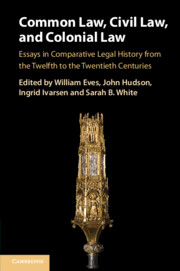56 results
Hydrothermal Reactions of Strontium and Transuranic Simulator Elements with Clay Minerals, Zeolites, and Shales
-
- Journal:
- Clays and Clay Minerals / Volume 31 / Issue 2 / April 1983
- Published online by Cambridge University Press:
- 02 April 2024, pp. 113-121
-
- Article
- Export citation
A history of high-power laser research and development in the United Kingdom
- Part of
-
- Journal:
- High Power Laser Science and Engineering / Volume 9 / 2021
- Published online by Cambridge University Press:
- 27 April 2021, e18
-
- Article
-
- You have access
- Open access
- HTML
- Export citation
Contents
-
- Book:
- Common Law, Civil Law, and Colonial Law
- Published online:
- 01 April 2021
- Print publication:
- 15 April 2021, pp v-vi
-
- Chapter
-
- You have access
- Open access
- HTML
- Export citation
Index
-
- Book:
- Common Law, Civil Law, and Colonial Law
- Published online:
- 01 April 2021
- Print publication:
- 15 April 2021, pp 323-338
-
- Chapter
-
- You have access
- Open access
- HTML
- Export citation
Contributors
-
- Book:
- Common Law, Civil Law, and Colonial Law
- Published online:
- 01 April 2021
- Print publication:
- 15 April 2021, pp vii-viii
-
- Chapter
-
- You have access
- Open access
- HTML
- Export citation
Acknowledgments
-
- Book:
- Common Law, Civil Law, and Colonial Law
- Published online:
- 01 April 2021
- Print publication:
- 15 April 2021, pp ix-x
-
- Chapter
-
- You have access
- Open access
- HTML
- Export citation
Copyright page
-
- Book:
- Common Law, Civil Law, and Colonial Law
- Published online:
- 01 April 2021
- Print publication:
- 15 April 2021, pp iv-iv
-
- Chapter
-
- You have access
- Open access
- HTML
- Export citation

Common Law, Civil Law, and Colonial Law
- Essays in Comparative Legal History from the Twelfth to the Twentieth Centuries
-
- Published online:
- 01 April 2021
- Print publication:
- 15 April 2021
-
- Book
-
- You have access
- Open access
- Export citation
Follow Up of GW170817 and Its Electromagnetic Counterpart by Australian-Led Observing Programmes
- Part of
-
- Journal:
- Publications of the Astronomical Society of Australia / Volume 34 / 2017
- Published online by Cambridge University Press:
- 20 December 2017, e069
-
- Article
-
- You have access
- HTML
- Export citation
Temperature-dependent signals in STEM Electron Beam-Induced Current (EBIC) Imaging
-
- Journal:
- Microscopy and Microanalysis / Volume 23 / Issue S1 / July 2017
- Published online by Cambridge University Press:
- 04 August 2017, pp. 1506-1507
- Print publication:
- July 2017
-
- Article
-
- You have access
- Export citation
Nanoscale Mapping of Interfacial Electrical Transport in Graphene-MoS2Heterostructures with STEM-EBIC
-
- Journal:
- Microscopy and Microanalysis / Volume 22 / Issue S3 / July 2016
- Published online by Cambridge University Press:
- 25 July 2016, pp. 1552-1553
- Print publication:
- July 2016
-
- Article
-
- You have access
- Export citation
The Parkes-MIT-NRAO Southern Sky Survey at 4850 MHz
-
- Journal:
- Publications of the Astronomical Society of Australia / Volume 9 / Issue 2 / 1991
- Published online by Cambridge University Press:
- 25 April 2016, pp. 243-245
-
- Article
- Export citation
In Situ Scanning Transmission Electron Microscopy (STEM) of Individual Electrochemical Intercalation Events in Graphite
-
- Journal:
- Microscopy and Microanalysis / Volume 21 / Issue S3 / August 2015
- Published online by Cambridge University Press:
- 23 September 2015, pp. 1193-1194
- Print publication:
- August 2015
-
- Article
-
- You have access
- Export citation
Introduction to Plasmon Energy Expansion Thermometry
-
- Journal:
- Microscopy and Microanalysis / Volume 21 / Issue S3 / August 2015
- Published online by Cambridge University Press:
- 23 September 2015, pp. 1907-1908
- Print publication:
- August 2015
-
- Article
-
- You have access
- Export citation
Time-Resolved Imaging of Electrochemical Switching in Nanoscale Resistive Memory Elements
-
- Journal:
- Microscopy and Microanalysis / Volume 21 / Issue S3 / August 2015
- Published online by Cambridge University Press:
- 23 September 2015, pp. 1911-1912
- Print publication:
- August 2015
-
- Article
-
- You have access
- Export citation
Applications of Plasmon Energy Expansion Thermometry
-
- Journal:
- Microscopy and Microanalysis / Volume 21 / Issue S3 / August 2015
- Published online by Cambridge University Press:
- 23 September 2015, pp. 663-664
- Print publication:
- August 2015
-
- Article
-
- You have access
- Export citation
Contributors
-
-
- Book:
- The Cambridge Dictionary of Philosophy
- Published online:
- 05 August 2015
- Print publication:
- 27 April 2015, pp ix-xxx
-
- Chapter
- Export citation
Contributors
-
-
- Book:
- Clinical Gynecology
- Published online:
- 05 April 2015
- Print publication:
- 23 April 2015, pp viii-xiv
-
- Chapter
- Export citation
Contributors
-
-
- Book:
- Comprehensive Management of Arteriovenous Malformations of the Brain and Spine
- Published online:
- 05 January 2015
- Print publication:
- 08 January 2015, pp x-xiv
-
- Chapter
- Export citation
In Situ STEM of Ag and Cu Conducting Bridge Formation through Al2O3 in Nanoscale Resistive Memory Devices
-
- Journal:
- Microscopy and Microanalysis / Volume 20 / Issue S3 / August 2014
- Published online by Cambridge University Press:
- 27 August 2014, pp. 1550-1551
- Print publication:
- August 2014
-
- Article
-
- You have access
- Export citation



